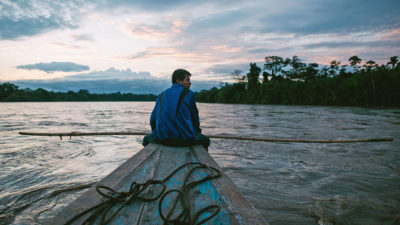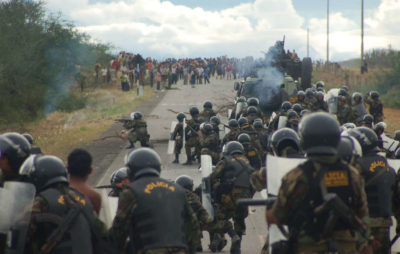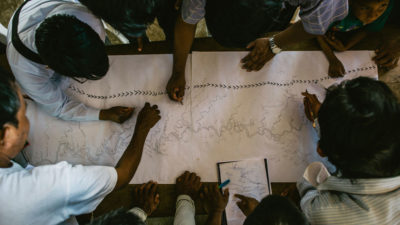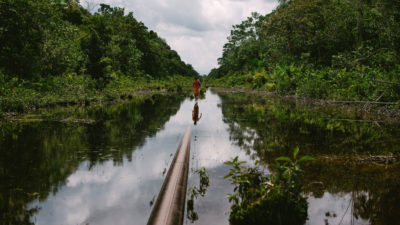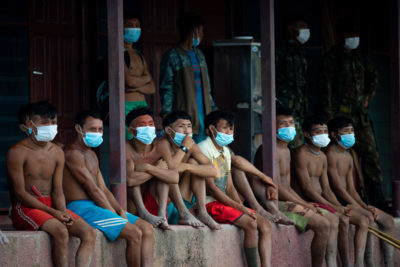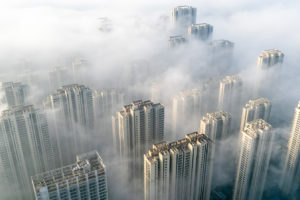Indigenous rainforest communities in northern Peru have chalked up a significant victory in their efforts to expel oil companies from their lands. Last week, the Chilean oil giant GeoPark withdrew from a project that the company had earlier claimed would deliver enough oil to supply a quarter of Peru’s needs.
But the victory was bittersweet. For it came just two weeks after the death from Covid-19 of one of the tribal leaders who has spearheaded the campaign to repel Big Oil — and there is growing concern that the spread of the virus in this remote region of the Amazon rainforest could have been triggered by employees of oil companies.
GeoPark gave up its role as the operator of Block 64, covering traditional territories of the Achuar and Wampis people the size of New Jersey, citing “force majeure,” meaning extraordinary circumstances beyond their control. Its letter to its partner, the state oil company Petroperu did not specify what those circumstances were.
But it came after a year in which the two Indigenous groups had contested and forced the company to withdraw an environmental impact assessment on the project, making action within the project area illegal, and two months after the Wampis presented a criminal complaint with local prosecutors, claiming the company’s staff were moving around the forest in breach of Peru’s coronavirus lockdown.
Shapiom Noningo, technical director of the Wampis nation, called the departure of GeoPark a “temporary victory.” Petroperu says it will announce within the next month whether it plans to continue alone, find another partner, or pull out. Meanwhile, the people of the forests face a second external threat: Covid-19.
For Indigenous communities, nothing — not even Big Oil — represents the globalization of their world as much as the virus.
The death from the virus of Santiago Manuin, chief of the neighboring Awajun people, early this month was a shocking blow to communities for whom nothing — not even Big Oil — currently represents the globalization of their world as much as the virus. His life and death represented both their tribal strength and their global vulnerability. How the story plays out will probably decide their future and that of the rainforests of the Peruvian Amazon, since the Indigenous communities there are the last guarantors of those rainforests.
A 2017 study by Allen Blackman of the Washington think tank Resources for the Future found that where Indigenous communities in the Peruvian Amazon have won legal title to their ancestral lands, this “reduces [forest] clearing by more than three-quarters, and forest disturbance by roughly two-thirds.”
The story of the conflict between Big Oil and the Indigenous people of the Peruvian Amazon has many twists and turns, and the outcome remains far from certain.
Manuin was part of a generation of Indigenous leaders in the rainforests of northern Peru and eastern Ecuador who have fought, sometimes literally, to achieve greater autonomy over their territories. He was both a diplomat and a warrior.
When Pope Francis visited the Peruvian Amazon in 2018, Manuin was one of the Indigenous leaders he met. The Pope was photographed wearing a feathered headdress and a string of beads that Manuin gave him.
The 2009 standoff between police and Indigenous protesters, known as Bagua massacre, led to the deaths of 30 demonstrators and 12 policemen. Courtesy of Thomas Quirynen/Survival International
But Manuin was only free to hand over the papal headdress because, a year earlier, a court had thrown out charges against him and 51 others from the Awajun and Wampis communities. They were charged in the killing of 12 police officers during the bloody conclusion to a 57-day long blockade of a key highway in 2009 by the communities. They had been protesting against government plans to allow oil and mining companies into their territories, apparently to comply with a recent free-trade deal between Peru and the United States.
More than 30 people died and 200 were injured when police and security forces fired on hundreds of the protesters, who responded by grabbing police guns and shooting back. It was a battle in which Manuin received eight bullet wounds, and after which he faced a jail term of up to 35 years.
What became known as the Bagua massacre, after a nearby town, emerged as a defining moment in a long struggle for Indigenous rights in the Peruvian Amazon.
Initially, it seemed as if the Indigenous protesters had been defeated. In the months afterward, the government of President Alan Garcia allocated hydrocarbon leases covering more than 30 percent of the Peruvian Amazon.
But the situation soon changed. In 2011, Ollanta Humala won the presidency on a ticket of social inclusion. Within weeks, his government repealed several of Garcia’s pro-Big Oil decrees and replaced them with a law giving Indigenous communities rights to be consulted about developments on their lands — rights that courts later interpreted as including a right to say no. In a final defusing of the tensions, all of the protesters put on trial for the Bagua massacre were acquitted in 2016.
In 2015, the Wampis became the first Peruvian Indigenous people to declare their own autonomous government.
“We both learned lessons” from the massacre, Manuin said later. “Violence brings no solutions.”
In the aftermath of the battle, the Indigenous peoples of northern Peru have moved on to seeking self-rule. In 2015, the 15,000 Wampis became the first to formally declare their own autonomous government, covering 85 communities in a roadless territory the size of Connecticut, along the rivers Santiago and Morona.
There was no pushback from the Humala government or its successors. “Until now, relations have been positive. We do not want independence, only to manage our territory,” said Noningo, in an interview for this article. “As the [Wampis] nation approaches its fifth birthday, no sector of the government has questioned our existence or how we are acting.”
Even relations with the military have remained good. “During the pandemic, the army has been an ally. We have been helping it with border control,” he said. In fact, according to one source, this collaboration has extended to the Wampis providing the military with gasoline and other supplies for their patrols.
None of this means that the threat from Big Oil has gone away. GeoPark held 75 percent of the rights to Block 64’s oil, but Petroperu is likely to try to replace the company with a new operating partner, says Noningo.
Any oil pumped from beneath Achuar lands would be moved by barge through Wampis territory to a pumping station on the existing North Peruvian oil pipeline, which since the 1970s has been taking oil from distant wells in northeastern Peru for 700 miles across Indigenous territories to the Pacific Ocean port of Bayovar.
Both the Achuar and Wampis communities have rejected the project, though a breakaway faction comprising members of both groups wants to negotiate with the company. Nor does the project thus far have government approval, thanks in part to Indigenous interventions.
A company environmental impact assessment (EIA) submitted two years ago was criticized by the government agency responsible for certification, following opposition from the Wampis and the Achuar. The agency said the assessment failed to recognize threats to either the environment or the Indigenous uses of natural resources. The company subsequently withdrew the EIA and failed to submit another before finally pulling out this month.
But the apparently favorable attitude of the Peruvian government toward an Indigenous veto on Big Oil may not last. Noningo told me before GeoPark’s withdrawal that “the government and the company want to convince us to allow them entry. No consultation has been attempted, but even if there are consultations, the government may unilaterally decide in the company’s favor.” So, Noningo said, “the Wampis and Achuar will not sit down for consultation, much less negotiation.”
Still, in recent times Indigenous communities have been going to the Peruvian courts with increasing success. Two years ago, the courts upheld their right to withhold consent for oil and gas exploration on their lands, and suspended activities by French and Canadian oil companies in another area under license, Block 116, which overlaps Wampis and Awajun territories.
Last year, Peru’s environmental regulator imposed more than $30 million in fines on the state oil company Petroperu, after the Wampis filed complaints following recent spills on their territory. The regulator found that the company had failed to clean up pollution from a pipeline pumping station near the Fernando Rosas community. A year after the leak, oil was still flowing into local streams used by the community for fishing and washing.
The North Peruvian Pipeline, operated by Petroperu, travels 700 miles across Indigenous territories to the Pacific Ocean port of Bayovar. Jacob Balzani
The communities are seeking international justice, too. In March this year, the Achuar, Kichwa, Kukama, and Quechua communities filed a complaint in the Netherlands against Pluspetrol, an Argentinian-owned company that is registered there, for polluting their forests and violating their rights over 15 years before closing operations in 2015.
The Indigenous communities listed almost 2,000 sites in their forests where oil spilling from pipelines — and heavy metals such as lead, barium, and cadmium seeping from waste dumps and production sites — had polluted soils, rivers, and groundwater.
Many of the violations have already been the subject of fines imposed on the company by Peruvian courts. But the communities said Pluspetrol had contravened guidelines of the intergovernmental Organization for Economic Co-operation and Development (OECD) on corporate social responsibility and asked the Dutch government to require it to mount a cleanup and make reparations.
As Peruvian Indigenous communities face the arrival of Covid-19, they are not alone among Amazon peoples seeking to protect themselves from this new danger. In Brazil, where more than 400 Indigenous people are known to have died from the virus in the Amazon, the Indigenous People Articulation (APIB), which represents communities, says health workers have brought the virus to remote areas of the Javari Valley Indigenous territory, which has the largest number of people living in extreme isolation.
The Kokama people, who live on the banks of the Amazon River upstream of Manaus, have suffered 57 deaths, with the initial infection reported again from a health worker, who had returned from a conference elsewhere in Brazil and failed to self-isolate afterward. Brazil’s Yanomami people, meanwhile, complain that they are at risk from some 20,000 illegal gold miners on their lands in recent months, according to Julio Araujo of the Rio de Janeiro State University.
A Wampis spokesman says one good outcome of the pandemic has been a brief cessation of invasions by illegal loggers.
In the Amazon region of Ecuador, the Waorani people won a court case last month forcing their government to take urgent action to keep the virus off their lands and the territory of neighboring uncontacted groups and to provide testing and other medical assistance.
Brazil and Peru have the two highest rates of infection and deaths in South America. The Pan American Health Organization estimated as early as late May that 20,000 people were infected in remote regions of the Amazon Basin. Many Indigenous communities saw the coronavirus wave coming. In April, the Wampis warned that they faced “large-scale deaths” if the virus spread through their territory, because of the poverty of many of its members and the poor local health services.
After Manuin died in a hospital in the Peruvian coastal town of Chiclayo on July 1, following an evacuation from his home in the town of Nieva on the edge of the rainforest, his daughter Luz Angelica Manuin told reporters: “Many people have died; the community are holding vigils and burying them. The government has forgotten about us.”
Manuin’s death came less than two weeks after that of another of the region’s most famous Indigenous leaders, Paulinho Paiakan, chief of the Kayapó people in the Brazilian Amazon.
From the start of the pandemic, the Wampis had highlighted the risks from oil companies. They claimed that GeoPark was moving people from cities with coronavirus cases into their forests.
After the company ignored their requests to remove staff from the area, the Wampis filed a complaint with the criminal prosecutor’s office in Datem del Maranon province. It alleged that the company’s people were moving around Block 64, in defiance of the national coronavirus lockdown and of the Wampis’ own decision to close their territory to outsiders. Some Wampis also suggested that company community-relations workers had been visiting villages to drum up support for those who wanted a deal with the company.
Yanomami Indigenous people await medical attention amid the Covid-19 pandemic on July 1 in Roraima, Brazil. Andressa Anholete / Getty Images
GeoPark denied that its staff had infringed on the lockdown, but it subsequently flew them all out. None tested positive for the virus on departure, it said.
Manuin died a month after the complaint was filed with the prosecutor’s office. Since Manuin was not living in the area where the company workers operated, there is unlikely to be a direct link. But his death, and that of others from the virus, underlines the new vulnerability to the outside world felt by many in the forests.
Noningo says one good outcome of the pandemic has been a brief cessation of invasions by illegal loggers. The Wampis don’t expect that to last. “We had a plan to mobilize prosecutions, and we will revive that when they return,” he said. “If that doesn’t work, we will requisition the wood and kick out the loggers.”
There are other looming threats to the integrity of the Wampis nation and other Indigenous territories in northern Peru. They include a plan for the first road through Wampis territories. But the biggest, said Noningo, is the long-proposed mega-dam at the Pongo de Manseriche, a spectacular gorge on the currently free-flowing Marañón River. With a slated capacity of up to 10,000 megawatts, it could be one of the world’s largest hydroelectric dams — and one of the most controversial.
The dam would have major downstream impacts, reducing sediment flows into the main Amazon River, according to a study by the Wildlife Conservation Society. It would also drown Awajun and Wampis territory, including the town of Nieva, where Manuin lived until his death. If the dam project leaves the drawing board, it could precipitate a “second Bagua,” locals say.
But for now, for all their growing power and assertiveness — and their new success in repulsing GeoPark — the forest communities of northern Peru still face the two more immediate threats: Big Oil and the virus.
